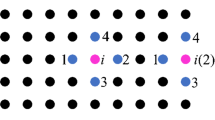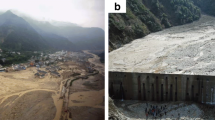Abstract
As a meshfree method, the smoothed particle hydrodynamics method (SPH) is suitable for fluid–particle–solid (FPS) interaction problems, such as abrasive water-jet (AWJ) impacting process. However, the fully resolved SPH model requires fine resolution of discrete particles and the computation is expensive. The coupled method of SPH and discrete element method (DEM) may be a more effective approach. A coupled SPH–DEM unresolved model is proposed in this study for AWJ simulation, which containing water-jet flow, metallic solid and abrasive particles. The fluid and solid phases are discretized with SPH particles, and the abrasives are described by the DEM method. The coupling between SPH and DEM is achieved based on the so-called local averaging techniques. To enforce the efficient interaction between SPH–DEM and SPH–SPH, a double-layer linked-list neighboring particle searching procedure is proposed for establishing particle-pair in each time step, resulting in diverse smoothing lengths in the domain. Four numerical cases are conducted to verify the model’s applicability including single/multiple particle sedimentation and continuous/discontinuous AWJ impact. The erosion process of plastic deformation, failure and material removal by AWJ impact is reproduced. The new coupled model has more computational efficiency. Results show that discontinuous AWJ has less erosion rate and more energy efficient than continuous AWJ. The effects of distance between adjacent water columns on crater profiles by discontinuous AWJ is also involved. This model has more efficiency to be suitable for the research of AWJ and complex fluid particle flow.

























Similar content being viewed by others
References
Canelas RB, Crespo AJC, Dominguez JM et al (2016) SPH–DCDEM model for arbitrary geometries in free surface solid–fluid flows. Comput Phys Commun 202:131–140
Liu HT (2010) Waterjet technology for machining fine features pertaining to micromachining. J Manuf Process 12(1):8–18
Tirumala D, Gajjela R, Das R (2018) ANN and RSM approach for modelling and multi objective optimization of abrasive water jet machining process. Decis Sci Lett 7(4):535–548
Nyaboro J, Ahmed M, El-Hofy H et al (2021) Experimental and numerical investigation of the abrasive waterjet machining of aluminum-7075-T6 for aerospace applications. Adv Manuf 9(2):286–303
Kurnenkov A, Shurigin A, Glebov V (2019) Investigation of the process of abrasive waterjet cutting of steels based on numerical simulation. MATEC Web Conf 298(2):00103
Maniadaki K, Kestis T, Bilalis N et al (2007) A finite element-based model for pure waterjet process simulation. Int J Adv Manuf Technol 31(9–10):933–940
Hsu CY, Liang CC, Teng TL et al (2013) A numerical study on high-speed water jet impact. Ocean Eng 72:98–106
Ma L, Bao R, Guo Y (2008) Waterjet penetration simulation by hybrid code of SPH and FEA. Int J Impact Eng 35(9):1035–1042
Junkar M, Jurisevic B, Fajdiga M et al (2006) Finite element analysis of single-particle impact in abrasive water jet machining. Int J Impact Eng 32(7):1095–1112
Takaffoli M, Papini M (2012) Material deformation and removal due to single particle impacts on ductile materials using smoothed particle hydrodynamics. Wear 274:50–59
Takaffoli M, Papini M (2012) Numerical simulation of solid particle impacts on Al6061-T6 part I: three-dimensional representation of angular particles. Wear 292:100–110
Hadavi V, Papini M (2015) Numerical modeling of particle embedment during solid particle erosion of ductile materials. Wear 342:310–321
Wang JM, Gao N, Gong WJ (2010) Abrasive waterjet machining simulation by coupling smoothed particle hydrodynamics/finite element method. Chin J Mech Eng 5:568
Du MC, Zhang K, Liu YL et al (2022) Experimental and simulation study on the influence factors of abrasive water jet machining ductile materials. Energy Rep 8:11840–11857
Liu XH, Liu SY, Ji HF (2015) Numerical research on rock breaking performance of water jet based on SPH. Powder Technol 286:181–192
Jiang HX, Liu ZH, Gao KD (2017) Numerical simulation on rock fragmentation by discontinuous water-jet using coupled SPH/FEA method. Powder Technol 312:248–259
Ren FS, Fang TC, Cheng XZ (2019) Theoretical modeling and experimental study of rock-breaking depth in particle jet impact drilling process. J Petrol Sci Eng 183:106419
Ren FS, Fang TC, Cheng XZ (2020) Study on rock damage and failure depth under particle water-jet coupling impact. Int J Impact Eng 139:103504
Fang TC, Ren FS, Liu HX et al (2021) Progress and development of particle jet drilling speed-increasing technology and rock-breaking mechanism for deep well. J Petrol Explor Prod Technol 12:1697–1708
Liu SY, Liu ZH, Cui XX et al (2014) Rock breaking of conical cutter with assistance of front and rear water jet. Tunn Undergr Space Technol 42:78–86
Yuan QQ, Wang C, Wang YQ et al (2019) Investigation of submerged soil excavation by high-velocity water jet using two-fluid smoothed particle hydrodynamics method. J Hydraul Eng 145(6):04019016
Wang C, Wang Y, Peng C et al (2016) Smoothed particle hydrodynamics simulation of water-soil mixture flows. J Hydraul Eng 142(10):04016032
Ge Z, Zhang D, Lu Y et al (2021) Propagation of stress wave and fragmentation characteristics of gangue-containing coal subjected to water jets. J Nat Gas Sci Eng 95:104137
Gotoh H, Khayyer A, Shimizu Y (2021) Entirely Lagrangian meshfree computational methods for hydroelastic fluid-structure interactions in ocean engineering—reliability, adaptivity and generality. Appl Ocean Res 115:102822
Luo M, Khayyer A, Lin P (2021) Particle methods in ocean and coastal engineering. Appl Ocean Res 114:102734
Dong XW, Li ZL, Jiang C et al (2019) Smoothed particle hydrodynamics (SPH) simulation of impinging jet flows containing abrasive rigid bodies. Comput Part Mech 6(3):479–501
Feng L, Liu GR, Li ZL et al (2019) Study on the effects of abrasive particle shape on the cutting performance of Ti-6Al-4V materials based on the SPH method. Int J Adv Manuf Technol 101(9):3167–3182
Yu R, Dong XW, Du MC et al (2022) Improved smoothed particle hydrodynamics (SPH) model for simulation of abrasive water-jet (AWJ). Int J Comput Methods 2143002.
Robinson M, Ramaioli M, Luding S (2014) Fluid–particle flow simulations using two-way-coupled mesoscale SPH–DEM and validation. Int J Multiph Flow 59:121–134
Xu WJ, Dong XY, Ding WT (2019) Analysis of fluid-particle interaction in granular materials using coupled SPH–DEM method. Powder Technol 353:459–472
Tang Y, Jiang Q, Zhou C (2018) A Lagrangian-based SPH–DEM model for fluid–solid interaction with free surface flow in two dimensions. Appl Math Model 62:436–460
Du M, Wang H, Dong H et al (2020) Numerical research on kerf characteristics of abrasive waterjet machining based on the SPH–DEM–FEM approach. Int J Adv Manuf Technol 111(11):3519–3533
Peng C, Zhan L, Wu W et al (2021) A fully resolved SPH–DEM method for heterogeneous suspensions with arbitrary particle shape. Powder Technol 387:509–526
Wu Z, Yu F, Zhang P et al (2019) Micro-mechanism study on rock breaking behavior under water jet impact using coupled SPH–FEM/DEM method with Voronoi grains. Eng Anal Boundary Elem 108:472–483
Kim J, Lee JH, Jang H et al (2021) Numerical investigation of scour by incompressible SPH coupled with coarse-grained DEM. Soil Dyn Earthq Eng 151:106998
Mao Z, Liu GR, Dong XW (2017) A comprehensive study on the parameters setting in smoothed particle hydrodynamics (SPH) method applied to hydrodynamics problems. Comput Geotech 92:77–95
Liu GR, Liu MB (2003) Smoothed particle hydrodynamics: a meshfree particle method. World Scientific, Singapore
Monaghan JJ, Lattanzio JC (1985) A refined particle method for astrophysical problems. Astron Astrophys 149:135–143
Anderson TB, Jackson R (1967) Fluid mechanical description of fluidized beds Equations of motion. Ind Eng Chem Fundam 6(4):527–539
He Y, Bayly AE, Hassanpour A et al (2018) A GPU-based coupled SPH–DEM method for particle-fluid flow with free surfaces. Powder Technol 338:548–562
Lo EYM, Shao S (2002) Simulation of near-shore solitary wave mechanics by an incompressible SPH method. Appl Ocean Res 24(5):275–286
Monaghan JJ (1992) Smoothed Particle Hydrodynamics. Ann Rev Astron Astrophys 30(1):543–574
Monaghan JJ (1994) Simulating free surface flows with SPH. J Comput Phys 110(2):399–406
Dong XW, Liu GR, Li ZL et al (2016) A smoothed particle hydrodynamics (SPH) model for simulating surface erosion by impacts of foreign particles. Tribol Int 95:267–278
Johnson GR, Cook WH (1985) Fracture characteristics of three metals subjected to various strains, strain rates, temperatures and pressures. Eng Fract Mech 21(1):31–48
Randles PW, Libersky LD (1996) Smoothed particle hydrodynamics: some recent improvements and applications. Comput Methods Appl Mech Eng 139(1–4):375–408
Cundall PA, Strack ODL (1979) A discrete numerical model for granular assemblies. Geotechnique 29(1):47–65
Norouzi HR, Zarghami R, Sotudeh-Gharebagh R et al (2016) Coupled CFD-DEM modeling: formulation, implementation and application to multiphase flows. Wiley, Hoboken
Scholtès L, Donzé FV (2013) A DEM model for soft and hard rocks: role of grain interlocking on strength. J Mech Phys Solids 61(2):352–369
Sun X, Sakai M, Yamada Y (2013) Three-dimensional simulation of a solid–liquid flow by the DEM–SPH method. J Comput Phys 248:147–176
Zhang S, Kuwabara S, Suzuki T et al (2009) Simulation of solid–fluid mixture flow using moving particle methods. J Comput Phys 228(7):2552–2565
Campbell J, Vignjevic R, Libersky L (2000) A contact algorithm for smoothed particle hydrodynamics. Comput Methods Appl Mech Eng 184(1):49–65
Ergun S (1952) Fluid flow through packed columns. Chem Eng Prog 48:89–94
Wen CY, Yu YH (1966) Mechanics of Fluidization. Chem Eng Prog Symp Ser 62:100–111
Wu K, Yang D, Wright N et al (2018) An integrated particle model for fluid–particle–structure interaction problems with free-surface flow and structural failure. J Fluids Struct 76:166–184
Zhang H, Tan Y, Shu S et al (2014) Numerical investigation on the role of discrete element method in combined LBM–IBM–DEM modeling. Comput Fluids 94:37–48
Dehkhoda S, Hood M (2014) The internal failure of rock samples subjected to pulsed water jet impacts. Int J Rock Mech Min Sci 66:91–96
Liu Y, Wei J, Ren T (2016) Analysis of the stress wave effect during rock breakage by pulsating jets. Rock Mechanics&Rock Engineering 49:503–514
Hu D, Li XH, Tang CL et al (2015) Analytical and experimental investigations of the pulsed air–water jet. J Fluids Struct 54:88–102
Funding
This work was supported by Natural Science Foundation of Shandong Province [Grant number ZR2021MA039].
Author information
Authors and Affiliations
Corresponding author
Ethics declarations
Conflict of interest
No potential conflict of interest was reported by the author(s).
Additional information
Publisher's Note
Springer Nature remains neutral with regard to jurisdictional claims in published maps and institutional affiliations.
Rights and permissions
Springer Nature or its licensor (e.g. a society or other partner) holds exclusive rights to this article under a publishing agreement with the author(s) or other rightsholder(s); author self-archiving of the accepted manuscript version of this article is solely governed by the terms of such publishing agreement and applicable law.
About this article
Cite this article
Yu, R., Dong, X., Li, Z. et al. A coupled SPH–DEM model for erosion process of solid surface by abrasive water-jet impact. Comp. Part. Mech. 10, 1093–1112 (2023). https://doi.org/10.1007/s40571-023-00555-4
Received:
Revised:
Accepted:
Published:
Issue Date:
DOI: https://doi.org/10.1007/s40571-023-00555-4




